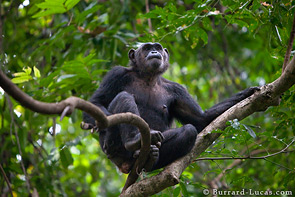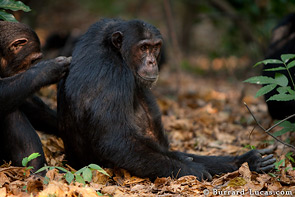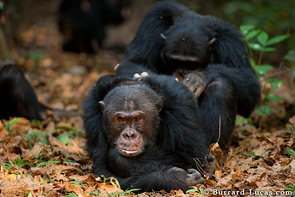In 2004, we travelled to a remote region of Tanzania – the Mahale Mountains National Park. Sandwiched between the shores of Lake Tanganyika and the 2,000m high peaks of the Mahale Mountains, the park is known as one of the few places where it is possible to see chimpanzees in the wild. It is difficult to describe the sense of mystery and excitement that we felt upon arriving at the Park as the hoots and screams of chimpanzees and other primates echoed through the dark forest. We had an incredible experience watching and photographing the chimps in their natural environment. Some of our photographs from this first expedition proved to be very successful, one of them even earning me a win in Wildlife Photographer of the Year 2005. As a result, Mahale has always been a special place for us and we have wanted to return ever since.
In August 2009 we had the opportunity to visit Mahale for a second time. On this occasion our cameras and lenses were better suited to the low light conditions of the jungle and we both had much more photographic experience.
The region is currently home to around 800 chimpanzees though only one troupe consisting of roughly 60 animals is habituated to people. This is known as the “M” group. This group was first habituated back in 1965 by Toshisada Nishida, a Japanese researcher. During our stay we where fortunate enough to meet Professor Nishida who happened to be in Mahale on holiday… his wealth of knowledge and stories about the chimps made for some fascinating conversations.
Chimpanzees are very social creatures and it is amazing to observe the complex hierarchies and relationships that exist within the troupe. At the top of this hierarchy is an alpha male chimpanzee – he can be recognised as all the other chimps show him great respect.
M group is currently under the tyrannical reign of Pimu, a very aggressive chimp. His violence has generated an unsettled atmosphere throughout the troupe, and we witnessed a number of impressive displays of strength and aggression from the big males. It was noticeable that the atmosphere was much more tense than in 2005 when Alofu was the alpha male.
One of the main concerns for the safety of the chimpanzees is disease transmission from humans. In recent years, 12 chimpanzees have died from the flu virus that would have been caught from visitors or researchers. Consequently, everyone who observes the chimps must wear face masks. The downside is that they caused our viewfinders to constantly fog up, so we had to try and hold our breath when taking photos – not an easy thing to do after a tough trek! At all times, we had to keep a distance of at least 10m from the chimps.

It was great to catch up on the stories of all the chimpanzees that we remembered from 2005. Once again we were very sad to leave Mahale and the chimps who have almost begun to feel like old friends.










These are excellent photographs.
I was interested by your comment about “cameras and lenses were better suited to the low light conditions of the jungle”. Could you provide some details of equipment/techinques you used?
I had some problems photographing howler monkeys in Costa Rica recently – thermal noise bacame a real problem. With a 400mm lens wide open I had to shoot at the max ISO to get a reasonable shutter speed. And, naturally, shooting up into trees made the subject really backlit.
Short of upgrading my camera body to a newer one with better sensor I’m not sure what to do. Any suggestions?
i love primates! i can watch them for hours tho my exposure has only been at the zoo. i have enjoyed them the most at the bronx zoo the most. they have a large population w/all ages.
Thanks for the comments!
Arrowsmith:
Even using the best cameras and lenses, noise will always be a problem when shooting in the jungle. Will and I were using canon 1d mkIII bodies with f/2.8 lenses (mostly the 70-200). We were frequently using ISO values up to 1600! Other than using the newest cameras with the fastest lenses at maximum aperture, there really isn’t much you can do. You could try using flash to illuminate the subject, but this might produce some unattractive lighting. Flash should also help to reduce the backlighting effect of shooting up into the sky.
These images are simply amazing. Such a study of character(s) and expression. I also found your text to be very informative and interesting. Bravo!
Wonderful work.. guys…
nice images and interesting spot….
i like the large image and nice DOF…
Matt, nice pose…
Hope to c more uploads..
cheers
Wow!!! good work!!
Nitin Sharma from INDIA.
thank you for sharing all those wonderful pics of
Chimpanzees they are awesome..your pics are very inspiring..
http://www.shariblog.com